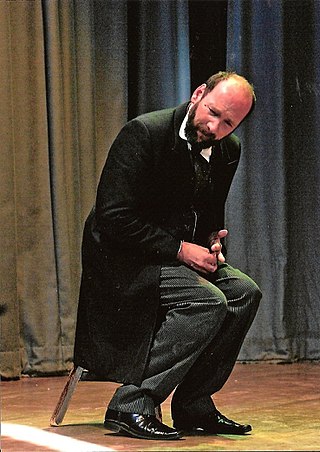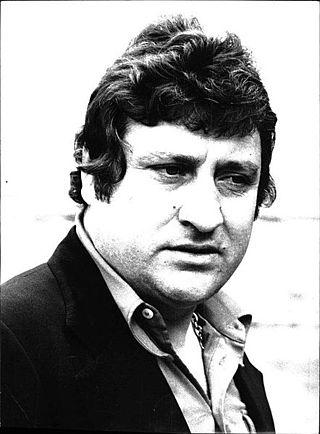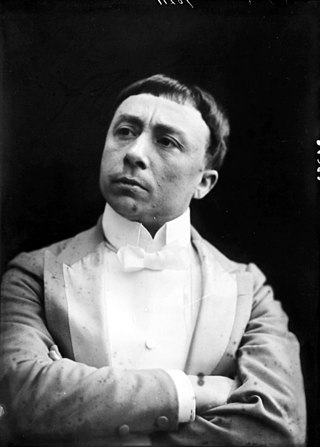
Macchietta (English: "little spot"; pl.: macchiette or macchiettas) is a form of comedy act which was common in Italian theatre between the late 1800s and the second half of the 1900s.

Macchietta (English: "little spot"; pl.: macchiette or macchiettas) is a form of comedy act which was common in Italian theatre between the late 1800s and the second half of the 1900s.
The macchietta consisted in comic musical monologues caricaturing stock characters. It was generally committed to the observation of reality, and it sketched characters featuring particular defects or manias, which were further deformed and exaggerated for comical and satirical effects. Every monologue had some music serving as backdrop for the whole performance and the acting was interspersed by brief couplets sung by the comedian. [2]
Macchiette were performed in café-chantants , revues and avanspettacolo , and less frequently as part of more elaborate comedy plays. After a golden age between the late 1800s and early 1900s, the genre apparently went out of fashion around 1920, before being resurrected in an amended and updated form in the 1930s, mostly thanks to the duo formed by Gigi Pisano and Giuseppe Cioffi, who created a series of popular macchiette such as "Ciccio Formaggio", "Mazza Pezza e Pizzo" and "Datemi Elisabetta", which were successfully performed by the most popular comedians of the time. [2]
Starting from the 1950s, the genre eventually declined and gradually disappeared together with the decline of avanspettacolo. [2]

Nicola Maldacea was among the first actors to adopt the genre, and he is regarded as the figure who mostly helped to canonize the macchietta, if not its inventor. [2] [3] He himself regarded himself as the person who coined the term. [3] Some of his macchiette had notable poets such as Trilussa, Salvatore Di Giacomo and Libero Bovio as often uncredited authors. [2]
Other well-known artists specialized in this form of entertainment were the Milan-based actor and playwright Edoardo Ferravilla , the Neapolitans Raffaele Viviani and Berardo Cantalamessa (creator of the classical macchietta "La risata"), and the Roman Ettore Petrolini. [2]

Harlequin is the best-known of the comic servant characters (Zanni) from the Italian commedia dell'arte, associated with the city of Bergamo. The role is traditionally believed to have been introduced by the Italian actor-manager Zan Ganassa in the late 16th century, was definitively popularized by the Italian actor Tristano Martinelli in Paris in 1584–1585, and became a stock character after Martinelli's death in 1630.

A comedian or comic is a person who seeks to entertain an audience by making them laugh. This might be through jokes or amusing situations, or acting foolish, or employing prop comedy. A comedian who addresses an audience directly is called a stand-up comedian.

A double act is a form of comedy originating in the British music hall tradition, and American vaudeville, in which two comedians perform together as a single act, often highlighting differences in their characters' personalities. Pairings are typically long-term, in some cases for the artists' entire careers. Double acts perform on the stage, television and film.

Silent comedy is a style of film, related to but distinct from mime, invented to bring comedy into the medium of film in the silent film era (1900s–1920s) before a synchronized soundtrack which could include talking was technologically available for the majority of films. Silent comedy is still practiced, albeit much less frequently, and it has influenced comedy in modern media as well.

A solo performance, sometimes referred to as a one-man show, one-woman show, or one-person show, features a single person telling a story for an audience, typically for the purpose of entertainment. This type of performance comes in many varieties, including autobiographical creations, comedy acts, novel adaptations, vaudeville, poetry, music and dance. In 1996, Rob Becker's Defending the Caveman became the longest-running one-person play in the history of Broadway theatre.

Alexis Valdés is a Cuban actor, comedian, monologist, film producer, playwright, poet, singer and screenwriter. He was born in Havana, Cuba, on August 16, 1963.

Commedia all'italiana, or Italian-style comedy, is an Italian film genre born in Italy in the 1950s and developed in the 1960s and 1970s. It is widely considered to have started with Mario Monicelli's Big Deal on Madonna Street in 1958, and derives its name from the title of Pietro Germi's Divorce Italian Style (1961). According to most of the critics, La Terrazza (1980) by Ettore Scola is the last work considered part of the commedia all'italiana.

Virgilio Riento was an Italian actor and comedian. He appeared in 108 films between 1936 and 1959.

Comedy is a genre of fiction that consists of discourses or works intended to be humorous or amusing by inducing laughter, especially in theatre, film, stand-up comedy, television, radio, books, or any other entertainment medium. The term originated in ancient Greece: In Athenian democracy, the public opinion of voters was influenced by political satire performed by comic poets in theaters. The theatrical genre of Greek comedy can be described as a dramatic performance pitting two groups, ages, genders, or societies against each other in an amusing agon or conflict. Northrop Frye depicted these two opposing sides as a "Society of Youth" and a "Society of the Old". A revised view characterizes the essential agon of comedy as a struggle between a relatively powerless youth and the societal conventions posing obstacles to his hopes. In this struggle, the youth then becomes constrained by his lack of social authority, and is left with little choice but to resort to ruses which engender dramatic irony, which provokes laughter.

Ludruk is one of the theatrical genres in East Java. It is a form of traditional performance presented by a troupe of actors on a stage, re-telling the life stories of everyday people and their struggles. Its origin is unclear, but it is believed to be dated as far back as the 13th century.

The sceneggiata or sceneggiata napoletana is a form of musical drama typical of Naples. Beginning as a form of musical theatre after World War I, it was also adapted for cinema; sceneggiata films became especially popular in the 1970s, and contributed to the genre becoming more widely known outside Naples. The most famous actors who played dramas were Mario Merola, Mario Trevi, and Nino D'Angelo.
Avanspettacolo is an Italian theatrical genre that developed between the 1930s and 1950s. Closely related to revue and variety show, avanspettacolo features a diverse mixture of music, ballet, sketch comedy, and other forms of entertainment. The genre emerged during the Fascist era, as a consequence of the promulgation of "modernist" laws that granted tax relief advantages to the theatres that were adapted to play movies. As a consequence, theatre companies were forced to devise a light and short form of representation that could be performed on the stage to entertain the audience before the "main show".

Nerone (1930) is an Italian comedy film, directed by Alessandro Blasetti. It stars Ettore Petrolini as the main actor. It has been described as a "Roman farce", a genre which was popular in Italy at the time. It is a parody of the Roman Empire and of the notorious Roman emperor, Nero. It was shot at the Cines Studios in Rome.

Ettore Petrolini was an Italian stage and film actor, playwright, screenwriter and novelist. He is considered one of the most important figures of avanspettacolo, vaudeville and revue. He was noted for his numerous caricature sketches, and was the "inventor of a revolutionary and anticonformist way of performing". Petrolini is also remembered for having created the "futurista" character Fortunello. His contribution to the history of Italian theater is now widely acknowledged, especially with regard to his influence on 20th century comedy. His iconic character Gastone became a byword in Italian for a certain type of stagey snob. His satirical caricature of the Roman Emperor Nero was widely perceived as a parody of Benito Mussolini, although it may itself have influenced the mannerisms of the Fascist dictator.

Tuccio Musumeci is an Italian actor and comedian.

Fiorenzo Fiorentini was an Italian actor, author, composer, screenwriter and radio personality.

Enzo Maggio was an Italian actor. He was the oldest of the Maggio siblings.

Nicola Maldacea was an Italian actor, comedian and singer, well-known for his expertise in the theatrical genre of 'macchietta', where he was one of the pioneer.
Television comedy is a category of broadcasting that has been present since the early days of entertainment media. While there are several genres of comedy, some of the first ones aired were variety shows. One of the first United States television programs was the comedy-variety show Texaco Star Theater, which was most prominent in the years that it featured Milton Berle - from 1948 to 1956. The range of television comedy has become broader, with the addition of sitcoms, improvisational comedy, and stand-up comedy, while also adding comedic aspects into other television genres, including drama and news. Television comedy provides opportunities for viewers to relate the content in these shows to society. Some audience members may have similar views about certain comedic aspects of shows, while others will take different perspectives. This also relates to developing new social norms, sometimes acting as the medium that introduces these transitions.
Modern stand-up comedy began around the turn of the century, evolving from a variety of sources including minstrel shows and vaudeville. Early stand-up comedians spoke directly to the audience as themselves without props or costumes, which distinguished these acts from vaudeville performances. These comics stood in front of the curtain during their shows, like early 20th century "front cloth" stand-up comics in Britain and Ireland whose numbers allowed the stage behind them to be re-set for another act.